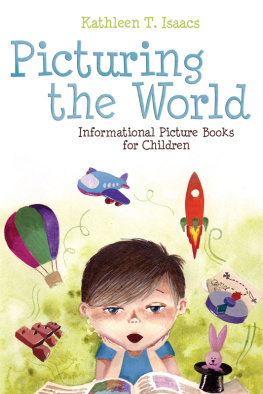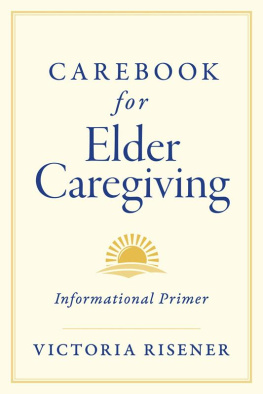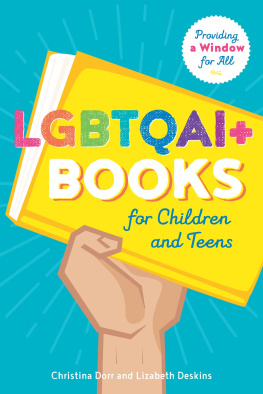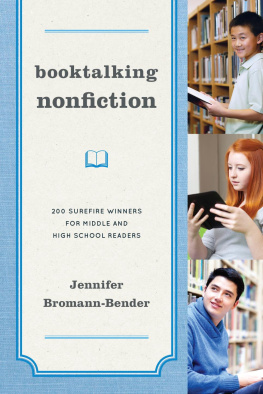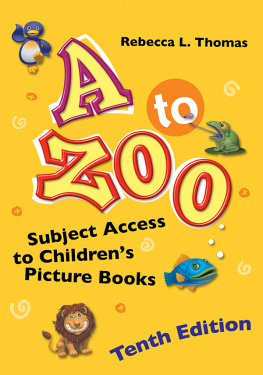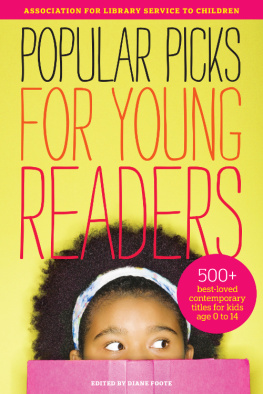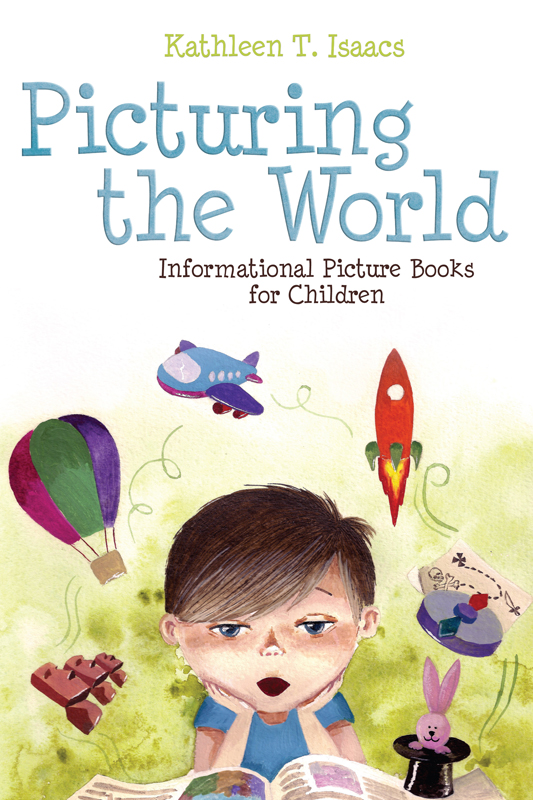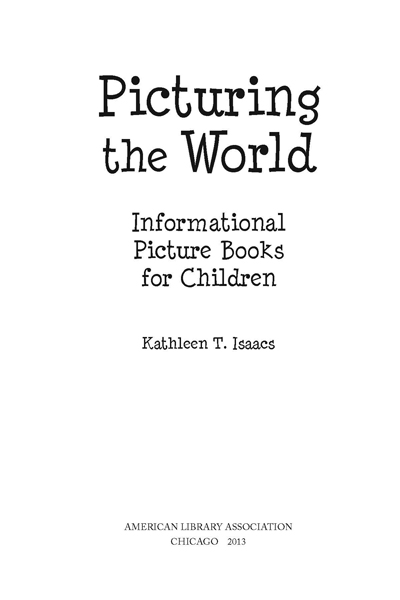ALA Editions purchases fund advocacy, awareness, and accreditation programs for library professionals worldwide.
KATHLEEN T. ISAACS spent many years as a teacher, with intermittent stints as a school and public librarian. She has taught in schools and universities in Baltimore, Washington, Hong Kong, and Xian, China, and has traveled extensively in many parts of the world. She has chaired selection committees for ALSCs Sibert Award, ALSCs Notable Childrens Books, and USBBYs Outstanding International Book Committees, and twice served as a member of ALSCs Newbery Award committee. Most recently, she has been teaching childrens literature in the education program at Towson University in Maryland. She regularly contributes articles and reviews to professional publications.
2013 by the American Library Association. Any claim of copyright is subject to applicable limitations and exceptions, such as rights of fair use and library copying pursuant to Sections 107 and 108 of the U.S. Copyright Act. No copyright is claimed for content in the public domain, such as works of the U.S. government.
Extensive effort has gone into ensuring the reliability of the information in this book; however, the publisher makes no warranty, express or implied, with respect to the material contained herein.
ISBNs: 978-0-8389-1126-6 (paper); 978-0-8389-9488-7 (PDF); 978-0-8389-9618-8 (ePub); 978-0-8389-9619-5 (Kindle). For more information on digital formats, visit the ALA Store at alastore.ala.org and select eEditions.
Library of Congress Cataloging-in-Publication Data
Isaacs, Kathleen T.
Picturing the world : informational picture books for children / Kathleen T. Isaacs.
pages cm
Includes bibliographical references and
ISBN 978-0-8389-1126-6 (pbk. : alk. paper) 1. Picture books for childrenUnited StatesBibliography. 2. Picture books for childrenEducational aspects. I. Title.
Z1033.P52I83 2013
011.62dc23
2012010059
Cover design by Kirstin Krutsch. Cover illustration Shutterstock, Inc.
To my children and my childrens children,
whose reading fueled a career.
Contents
W hen my children were very young, my mother-in-law decided to continue a grandparent present tradition dating back to my husbands childhood, a personal book-of-the-month club. Every year at Christmas, she gave me a large check; for the rest of the year, I purchased a book for each child every month. The children dutifully wrote thank-you notes for each book. (This made it a twofer present, encouraging both reading and writing). Ive continued that tradition for my grandchildren. Somewhere along the way, all those years of buying, reading, and giving childrens books turned into a career. Working as a librarian and teacher, reading, reviewing, discussing, and evaluating, Ive had the opportunity to admire a great deal of wonderful work by writers, illustrators, editors, and designers of childrens books. Within this small selection, I hope readers will find books that they will enjoy sharing with children as much as I have enjoyed the many I have shared over a great many years.
Credit for the concept of this book goes to Patricia Cianciolo, who began writing about illustration in childrens books in 1970, not long after I started looking at them as an adult. After several successful picture book bibliographies, she wrote Informational Picture Books for Children (ALA Editions, 2000), an annotated bibliography of titles published in the 1990s. That publication paved the way for this new selection.
What Are Informational Picture Books?
What we too often forget when considering the importance of nonfiction reading is the pleasure, the art, the wonder of it. We do not want to develop students who read nonfiction just for function, or for school success, but students who read nonfiction for enjoyment, to be fascinated, to discover.
NELL DUKE
W hat are informational books? Great stories that have the added advantage of being true. Thats how Dinah Stevenson, longtime childrens book editor and publisher, described them as we chatted in her ALA exhibit booth, surrounded by new and intriguing titles (pers. comm.). Nearly all informational books are about concrete subjects, things that can be seen and heard and touched, the lives of real people, places that can be visited, or the stories of real events. That connection with the real world is the heart of the attraction of informational books. Kids want to know truths, Susan Kuklin, a prolific nonfiction author, wrote about her work. Parents and teachers seeking to encourage young people to become readers will find such books an excellent bridge between their childrens lives and personal interests and the larger world waiting for their discovery. For young children, parents and teachers begin with picture books.
From birthand perhaps even beforechildren strive to learn about the world around them. Throughout their childhood, books help in this task. Books with pictures are a natural starting point, since visual literacy starts long before a child can decode words on a page. Well before children can read, they can follow the pictures and put together the information they need to ask and answer questions and to grasp a story. For early readers, pictures continue to provide helpful cues to the text. Even for adults, its said, a picture is worth a thousand words. Today, in a world of ubiquitous screens and images, children expect to learn about their world through pictures. And advances in laser scanning technology and other changes in book production over the last forty years have made it possible to produce reasonably priced books with astonishing images on every page. A wealth of attractive and interesting picture books has been the result. Those that are factual, as well, are informational picture books.
We are in the Golden Age of Picture Book Biography, author and blogger Marc Tyler Nobleman writes. These authors, illustrators, and publishers are referring to books about a wide variety of subjects, but all agreed that the picture book format is both popular and effective.
There is no question that these colorful books are eye-catching. Even my college students, in training to be teachers, confessed that when they chose books to read for the class they looked at the covers and the pictures. In evaluating informational books they wrote comments such as The pictures grabbed my attention and The book had real pictures which made it engaging and brought it to life. There is no lack of books to choose from. According to Bowkera company that charts publishing trends for libraries, publishers, and booksellersof over 14,000 informational books published for young children in 2008, half were illustrated. Most of those 7,000 new and backlist titles do not rely on illustration heavily enough to be considered picture books, but a substantial number certainly were (R. Staats, Bowker, unpublished data). It can be hard to know how to choose among them.
In January 2011, the Association of Booksellers for Children and Bowker Pubtrack announced the results of a study that surprised and pleased many in the childrens book world. Among its conclusions: consumers still value books and reading over all other media in childrens lives; and, parents, teachers, relatives, librarians and booksellers are the most important influences in their reading choices.we need to educate ourselves to be the most positive, knowledgeable influences we can be. This is where selection tools such as this book, review magazines and websites, award lists, and library and booksellers suggestions come in. We need many pairs of eyes, many readers to assess the available books and find the best and the most appropriate for the young readers we serve.

